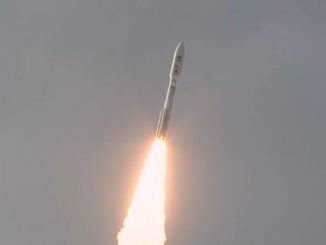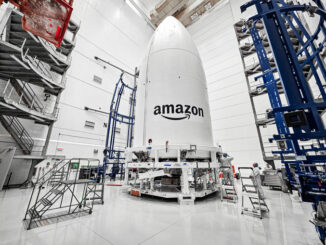
The successful maiden flight of SpaceX’s Falcon Heavy rocket in February was enough for the U.S. Air Force to certify the huge booster to carry the military’s most precious cargo into orbit, beginning with the mid-2020 launch of a classified payload under a $130 million contract awarded last week.
The Air Force announced the launch contract for the classified AFSPC 52 mission June 21 after a competition between SpaceX and United Launch Alliance. The military has not revealed the identity or purpose of the spacecraft slated to fly on the AFSPC 52 mission.
The mission is scheduled to lift off from pad 39A at NASA’s Kennedy Space Center in Florida before the end of September 2020, according to the Air Force.
The Air Force said in a statement that the $130 million contract with SpaceX provides the military with a “total launch solution” for the AFSPC 52 mission, including production of the Falcon Heavy launch vehicle, mission integration and launch operations.
“The competitive award of this EELV launch service contract directly supports Space and Missile Systems Center’s mission of delivering resilient and affordable space capabilities to our nation while maintaining assured access to space,” said Lt. Gen. John Thompson, Air Force program executive officer for space and SMC commander.
In a statement released to media, SpaceX president and chief operating officer Gwynne Shotwell said the Air Force has certified the Falcon Heavy to carry the military’s critical payloads into orbit. An Air Force spokesperson confirmed that the service has certified the Falcon Heavy for national security space missions.
“SpaceX is honored by the Air Force’s selection of Falcon Heavy to launch the competitively-awarded AFSPC 52 mission,” Shotwell said in a statement. “On behalf of all of our employees, I want to thank the Air Force for certifying Falcon Heavy, awarding us this critically important mission, and for their trust and confidence in our company. SpaceX is pleased to continue offering the American taxpayer the most cost-effective, reliable launch services for vital national security space missions.”
SpaceX’s Falcon 9 rocket was certified to launch the U.S. military’s national security space missions in 2015, after 18 flights for NASA and commercial customers. SpaceX and the Air Force agreed on a different certification strategy for the Falcon Heavy to expedite its availability for national security space missions.
Claire Leon, director of SMC’s launch enterprise directorate until December, told reporters last year that the Air Force could certify the Falcon Heavy and award SpaceX a launch contract after one successful mission. Three Falcon Heavy launches would be required before flying the national security space mission, Leon said.
The second launch of SpaceX’s Falcon Heavy rocket is scheduled for November from the Kennedy Space Center, carrying numerous satellites into different orbits for the U.S. military, NASA, and research institutions. That mission was awarded to SpaceX in 2012 by the Air Force’s Space Test Program, which manages experimental space missions in which military officials accept more risk than for higher-priority projects providing navigation, secure communications, early warning, and reconnaissance capabilities.
The third Falcon Heavy mission, set for liftoff late this year or in early 2019, will launch the Lockheed Martin-built Arabsat 6A commercial communications for Saudi Arabia’s Arabsat.
ULA’s Atlas and Delta rocket families were the only launch vehicles certified to loft the U.S. government’s national security payloads until the SpaceX’s Falcon 9 became eligible to compete for military contracts in 2015. Since then, SpaceX has won contracts to launch up to five new-generation GPS navigation satellites, beginning later this year.
The Air Force selected ULA’s Atlas 5 rocket for three missions since competitive procurements began, all of which would have required the Falcon Heavy’s lift capability and were awarded before SpaceX’s heavy-lifter won certification for national security space launches.
The Air Force wants two launch providers eligible to compete for national security space missions to ensure military payloads have a ride to space, even if one rocket family suffers a failure.
In a draft solicitation released for the AFSPC 52 mission, the Air Force said the payload required a lift capacity of around 14,000 pounds, or 6,350 kilograms, into a geostationary transfer orbit ranging in altitude between 115 miles (185 kilometers) and 21,865 miles (35,188 kilometers), with an inclination of 27 degrees. At that time, the launch of the AFSPC 52 mission was expected in July 2020.
The final request for proposals released by the Air Force last year did not include the mass specification and orbit information.
Falcon 9 rockets have launched heavier payloads into geostationary transfer orbit, but they required the launcher’s full fuel reserve, forcing SpaceX to discard the Falcon 9’s first stage. The most powerful versions of ULA’s Atlas 5 rocket, with the added thrust of solid rocket boosters, could have lifted the seven-ton mass specified in the AFSPC 52 mission’s draft solicitation.
ULA is retiring the single-stick versions of its Delta 4 family next year, with the triple-core Delta 4-Heavy expected to continue flying into the early 2020s.
Email the author.
Follow Stephen Clark on Twitter: @StephenClark1.



